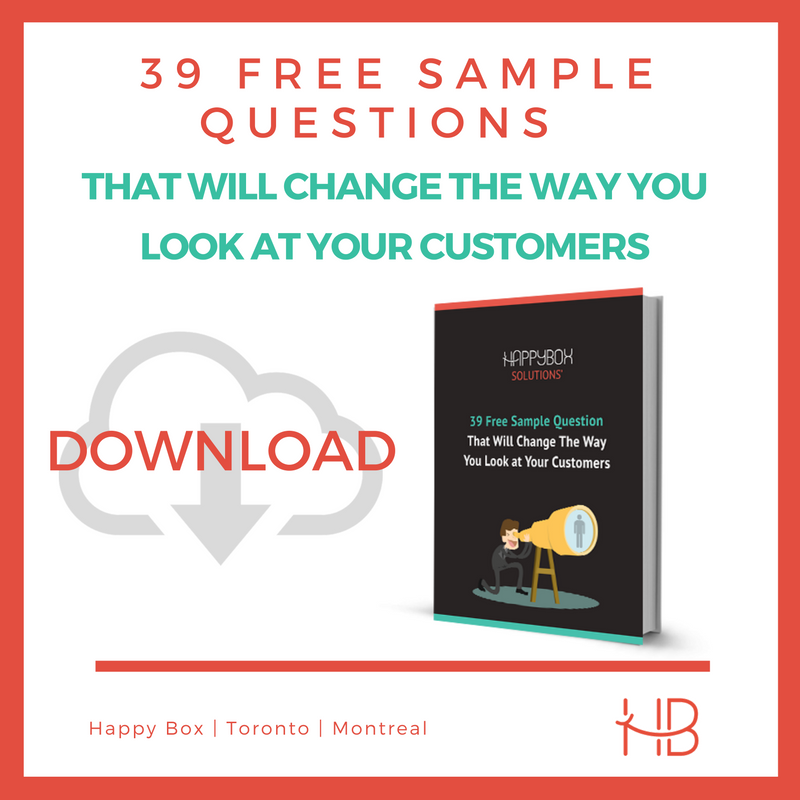The “Need-to-Know” Guide to Crafting Customer-Centric Marketing that Kicks Ass and Makes Sales
Creating Customer Centric Marketing Plan

Are you showing the same message to every customer?
I guarantee that your top competitors are NOT.
The old wisdom, “repeat, repeat, repeat,” used to be a definitive rule of advertising – but in today’s customer-centric universe, that old rule says exactly the opposite of what you should be doing.
To keep ahead of your competitors, you need to redesign the ways you approach your audience.
Instead of grouping everyone together into some massive indiscriminate melting pot, you need to break down your audience into different groups and recognizing different segments of your audience for their unique needs and expectations.
And once you understand your audience segments, you need to tailor your messages to the specific stage of the Buyer’s Journey that each of those individual people has reached.
This means not only tailoring your message based on the different channels (email, social media, paid ads, blogs etc..) where you communicate with your audience, but also based on the specific actions your customers have taken – actions that tell you where they are in their journey from initial curiosity to cash on the table.
The ROI is simple: The better you communicate with your audience on their terms, the more conversions you get.
Today we’ll show you our 5-Step process for gaining a deep understanding of your audience that’s will lay the foundation for all of your marketing strategies.
Step 1: Ask the right questions
Step 2: Gather data in the right places
Step 3: Segment your audience
Step 4: Map out your buyer’s journey
Step 5: Track. Execute. Adjust.
Step 1: Ask the right questions
Creating a persona is a little like creating a character – except that it’s based on hard facts instead of imagination.
The only way to get those hard facts, and make sure you’re getting a clear picture of your customer, is to ask the right questions.
Every business is unique, and the types of questions you ask need to be relevant to your business, your industry, and your audience.
To get you started, you can download questions my team and I think about when we’re gathering data to build customer personas for our clients.
Step 2: Gather data in the right places
Once you’ve got your list of questions, the next step is to find the right people to answer them.
First-person data is a great place to start. This data comes from customer behaviour patterns on your website, survey responses, verbatim quotes, and other self-reported sources.
Here are some of the top first-person data sources my team and I use when we’re building customer personas for our clients.
Website Analytics
Behaviour patterns on your website can provide deep insight into the needs and interests of your audience.
Data points like traffic source, page visits, page views, time on site and bounce rates can serve as solid starting points for understanding your audience’s consumption patterns.
Combine this quantitative data with qualitative data – such as, for example, heat mapping software, which visually maps where people are clicking on a page; and scroll mapping software, which maps how far people are scrolling down the page – and you’ve already got some basic vital stats on where your users are spending their time.
Social media discussions
People love to talk about themselves.
Ask the right question, in the right way, on social networks like Reddit.com and Quora, and you’ve got a free survey that’ll give you deeper insights on your audiences’ motivations and interests.
Discussions with your sales team
Your employees are on the front lines, which means they can bring you detailed insights about how your leads are behaving, how your buyers get talked into converting, and why your returning customers come back.
Make sure your people are dialoguing openly with every lead, whether they convert or not.
Interviews with customers
It doesn’t get more first-person than this.
Talk with your customers about how they found you, what their problem was, what made them hesitate before buying, and why they changed their minds.
Step 3: Segment Your audience
Once you’ve gathered as much data as possible from the sources above, it’s time to start assembling those quantitative and qualitative points into unified customer personas.

How many personas do you create?
The answer to this question depends on the number of distinct audiences you’re trying to target.
Just because someone holds a different job or position within an organization, that doesn’t necessarily mean their needs or buying requirements are different.
Remember, personas are descriptions of behaviours, and of the reasons for those behaviours. That means the number of distinct audiences you’re targeting – and the number of personas you should create – equals the number of distinct customer behaviour patterns you see in your data.
For each buyer segment, try and give as complete a picture as you can.
Use the questions you created in Step 1 and the answers you collected in Step 2 to create your personas. Feel free to answer in bullet points wherever you find it helpful. And don’t be afraid to ramble – there’s no such thing as too much information!
At the end, each of your buyer segments should look something like this:
Note: This is a fictional Buyer Segment based on a B2B SaaS company that sells lead management software to law firms.

Hi, I’m George.
Sample Buyer Segment
Name: George
Sex: Male
Age: 42
Position: Business Development Manager
Company: ABC Law Firm
Goals
Business goals:
- Increase business for the firm
- Improve the firms position against the competition
Personal goals:
- Demonstrate his value to firm owners
- Gain more recognition, respect, and responsibility at the firm
- Make more money
Goals that affect buying behaviour:
- Looking to increase business for the firm – so he’s looking at what his competitors are doing
- Better position against the competition – so he’s looking for latest trends/hacks within his industry
- Demonstrate value to firm owners – needs to be confident about the results/potential before presenting something to his team
- Gain more Recognition, Responsibility, Respect, at the firm – so he’s actively looking for opportunities to prove himself
- Make more money – wants to show that to gain big results, he needs to be a part of the growth strategy
Buyer mindset
Good Mindsets:
- Know they need help managing new accounts and leads.
- Have a specific budget in mind.
- Understand custom software costs money.
- Have a vision for what they want.
Bad Mindsets:
- Satisfied with the status quo
- Online software is complicated
- Older staff resistant to adopt new technology
Buyer Objections
Risks Considered:
- How much it’s going to cost
- What is their level of involvement
- How much control do they have over the software
- What is going to be the return – how much value are they going to get
- How much of their business is going to be affected
- Ability to “test” software before committing long-term
Common Objections:
- Too expensive
- Need to consider alternatives
- Need to discuss with other stakeholders
Potential reasons they DON’T choose you:
- Went with lower cost option
- Want to do it, but can’t afford it
- Decided that it’s not critical for the business today and will continue with the status quo
- Onboarding would be complex
Unspoken reasons that impact their decisions:
- Don’t trust what you’re saying
- Don’t understand what you’re saying – too technical
- They don’t like/connect with our company on a personal level
Buyer Influences
Information resources:
- Industry blogs, forums, professional communities, LinkedIn
- Networking events
- Referrals
Direct influencers:
- Firm partners
- Accountants
Indirect influencers:
- Industry standards
- Competitors
Information requirements throughout buying journey:
- Interest – they want to know industry related trends, tips, news, updates
- Evaluation – they want to read more about company and what you do
- Consideration – want proof and examples or success with businesses in their industry
- Commitment – want to see clear plan, budget, timeline for project
- Conversion – want clear communication and transparency of progress. hard numbers and verifiable results.
- Satisfaction – Maintain relationship and communication, ability to reach out for help if required, continued advice and engagement for improving business after project is complete
Once again, this is a sample of what information you could include in a Buyer Persona analysis. Remember that every business is unique, and the types of questions you ask need to be relevant to your business, industry, and audience.
Step 4: Map out your Buyer’s Journey
By now you should have a clear (or at least clearer) picture of your buyer’s goals, mindsets, buying requirements, and informational needs – as well as a sense of who they are, character-wise.
Now it’s time to map out the Buyer’s Journey of each of your buyer segments, and discover the best way to communicate with them at different stages in that Journey.
The message and calls-to-action you put in front of your audiences need to reflect their needs at the stages of the Buyer’s Journey they’ve reached.
For more detailed information on your Buyer’s Journey, make sure to read this detailed post we created. But for now, here’s a quick summary of the 6 stages of your Buyer’s Journey:
| Stage | Conversion Goal |
| Interest | Raise curiosity. Give your customers a reason to get in touch with you. |
| Evaluation | Provide valuable information that connects with your audience’s needs. |
| Consideration | Nurture your audience. Gain their trust and confidence. |
| Commitment | Manage expectations and set up for 100% satisfaction. |
| Conversion | Make them happy! Get the sale and deliver 110%. |
| Satisfaction | Get referrals, reviews, and upsells. |
For each stage of you Buyer’s Journey, you need to list out your customers goals, desires, and expectations – as well as the channels where you can find those specific customers.
NOTE: If you’re thinking, “Awww, come on, Sina! This seems like a ton of work!”… It is. I’m not gonna sugar-coat it.
But your buyer persona documents are going to turn out to be some of the most vital, useful resources you have in your marketing arsenal.
Here’s an example of how to organize your Buyer Journey Map document:
Step 5: Track. Execute. Adjust.
Congratulations! If you’ve made it this far, then you’ve got actionable descriptions of the way each audience segment behaves, and what they each want during different stages of their buying journey.
Now it’s time to start implementing your plan.
Before you pull the trigger on any of your marketing investments, here are some important considerations.
Plan the order in which you’ll implement your investments
Would you drive to the airport without knowing where you’re flying to? Probably not (unless you’re super adventurous!)
And my guess is you don’t want to be super adventurous with your marketing spend. Before you invest a single dollar, create a flowchart of the connections between each of your marketing activities, and plan out the order in which you’re going to implement them. This will also help you make sure you’re prioritizing critical marketing activities first.
Sometimes you have to choose which marketing activity you’ll prioritize. When this happens to me and my team, we evaluate each investment based on 3 criteria:
- Potential: How big is the potential return on investment (ROI) and how much does it cost?
- Importance: Is this a critical activity that needs to be completed before moving on to anything else?
- Ease: How easy and quickly can we implement the changes?
With the answers to those questions in hand, you’ll be well-equipped to put your priorities in order.
Create an analytics tracking plan
A detailed analytics plan will help you keep track of what’s working and what’s not. This plan should explain what information you need to capture, why it’s valuable, and how it’s going to help in future decision making.
Many good blog posts have been written on this subject over the years (one definitely worth reading is Avinash Kaushik’s post). Google also provides a number of good resources on the subject, for example here, or at the Analytics Academy.
Focus on continuous improvement
“Set it and forget it” is for rotisseries, not your marketing plan. Click To Tweet
The only way to push your marketing in the right direction is by continuously evaluating, testing, and tracking your results and assumptions – and making every improvement you can think of.
Those are the basics of creating customer personas for each stage of your Buyer’s Journey.
QUESTIONS, COMMENTS, STORY?
Do you have any questions or an interesting customer story you’d like to share? We’d love to hear about it! Go into the comments and share your story.
If you ever need help, we’re ready. Get in touch today >>
We promise not to bite. Hard.


